RuM
Rule Mining Made Simple
RuM is a desktop application that provides a comprehensive set of declarative process mining tools in a single unified package that is easy to use for both novices and experts of process mining. RuM is based on the process modeling language Declare but no prior experience with Declare is required to start using it.
The development of RuM has been partially supported by the Estonian Research Council (grant PRG887 and PRG1226) and by the UNIBZ project PRISMA.
For use in research cite as: BibTex
Latest version of RuM released on 08.11.2023 (version 0.7.2).
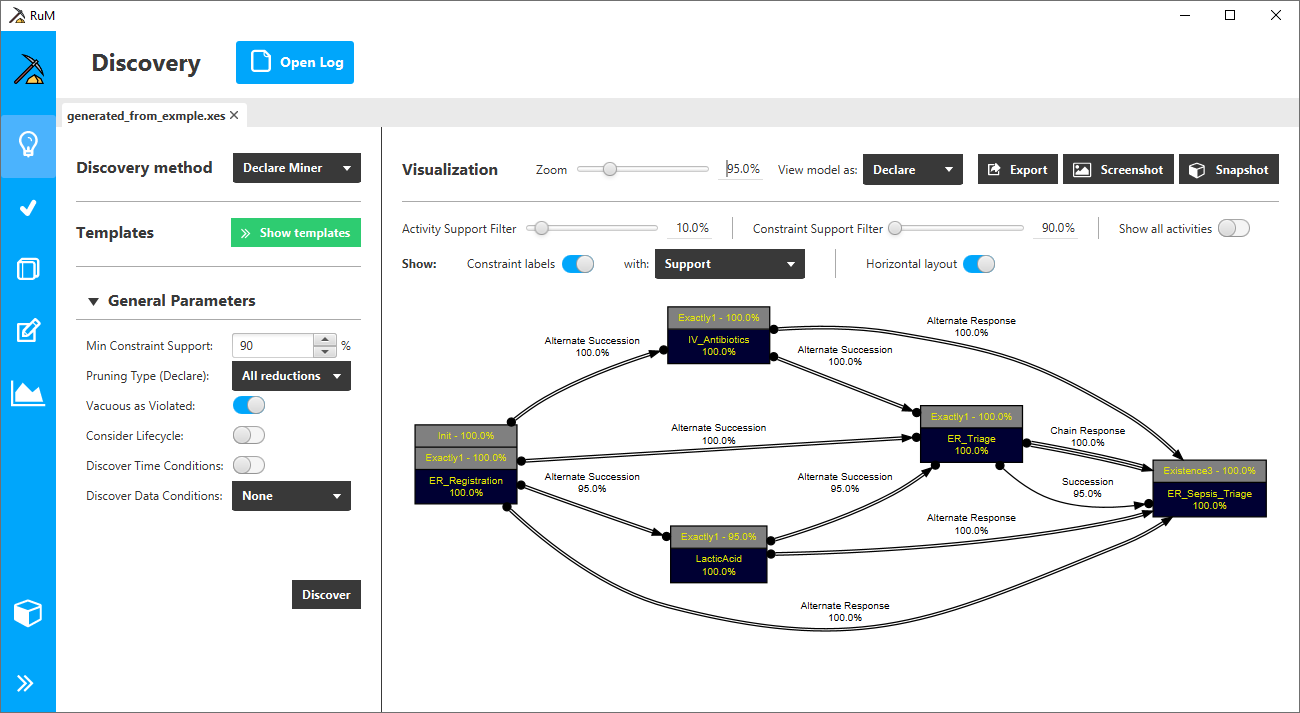
Process Discovery
Process discovery supports the Declare Miner and MINERful techniques. The results can be explored using the Declare graphical notation, a textual description of the discovered constraints or a formal representation of the model as an automaton.
Conformance Checking
Conformance checking supports the Declare Analyzer and the Declare Replayer methods. The conformance can be explored either by trace or by constraint.
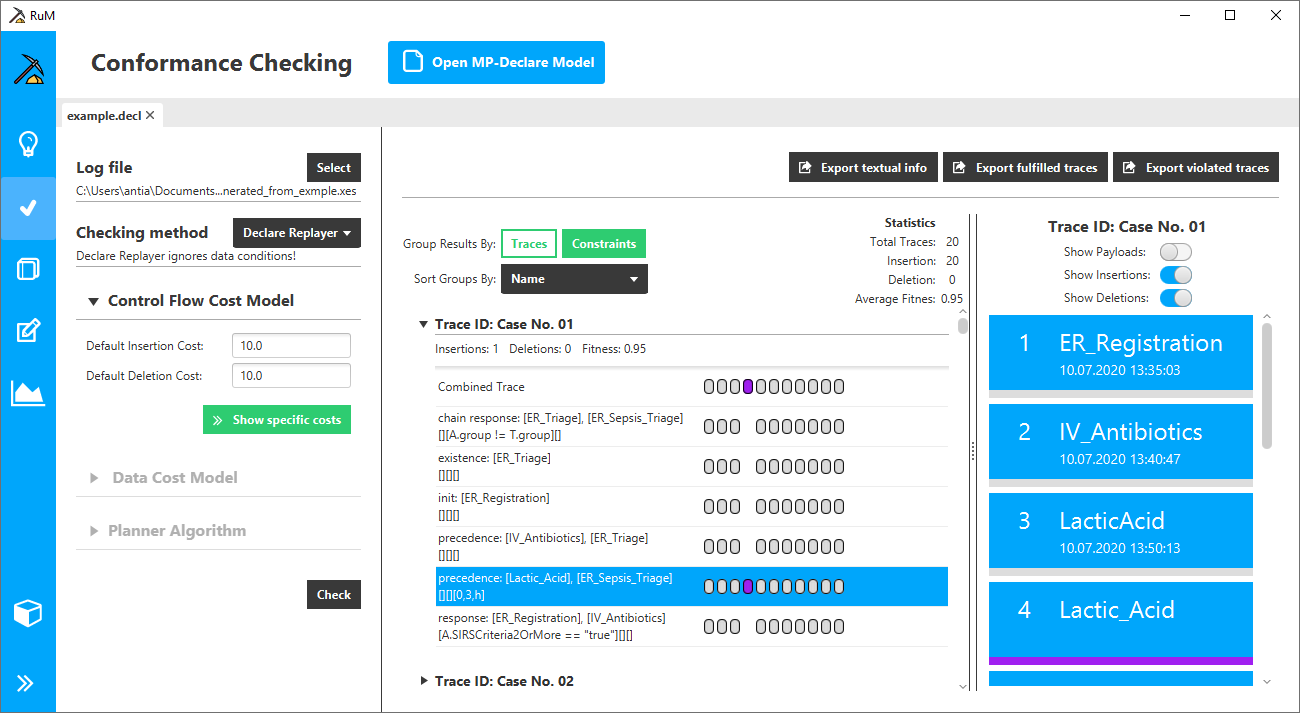
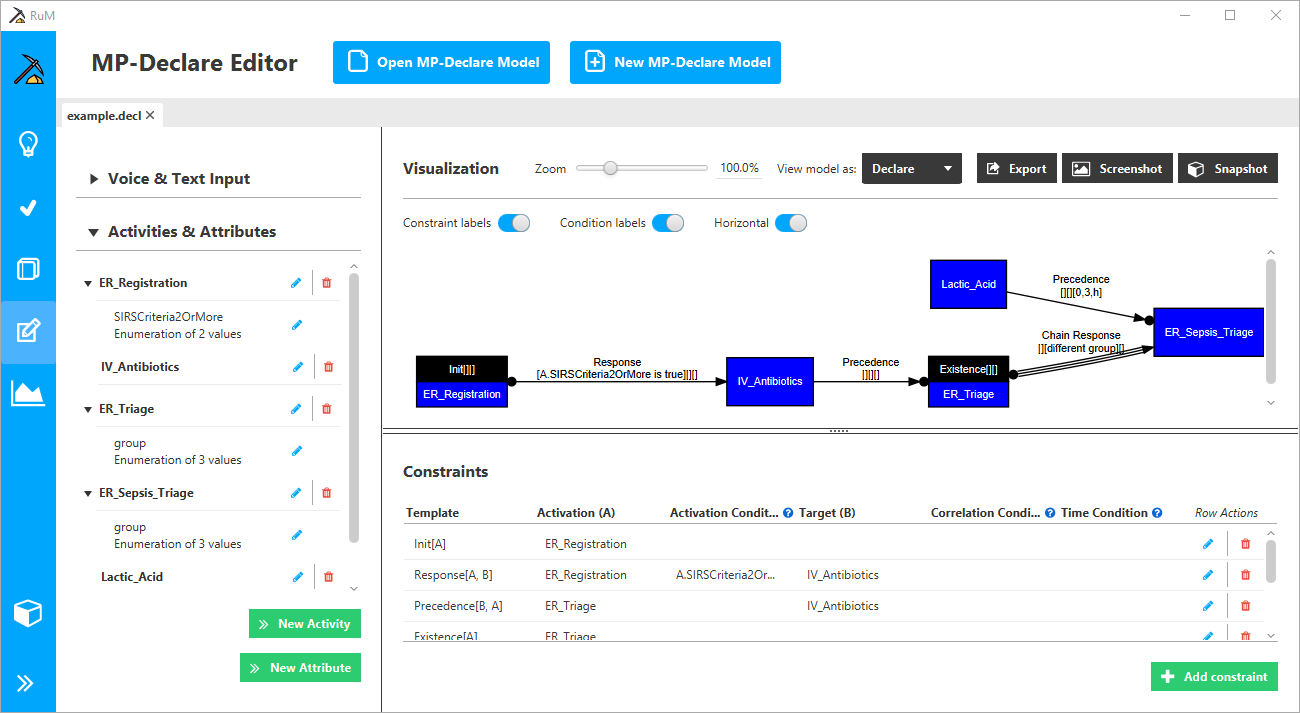
Declare Editor
RuM includes a model editor to define Declare constraints – also with data and time conditions, as specified by the multi-perspective version of Declare (MP-Declare).
RuM supports users in defining constraints using natural language text and speech recognition with its chatbot Declo (view demo).
Log Generation
Log generation supports the Alloy Log Generator and the MINERful Log Generator methods. The log, written in the XES format, can be readily explored and analyzed upon the generation.
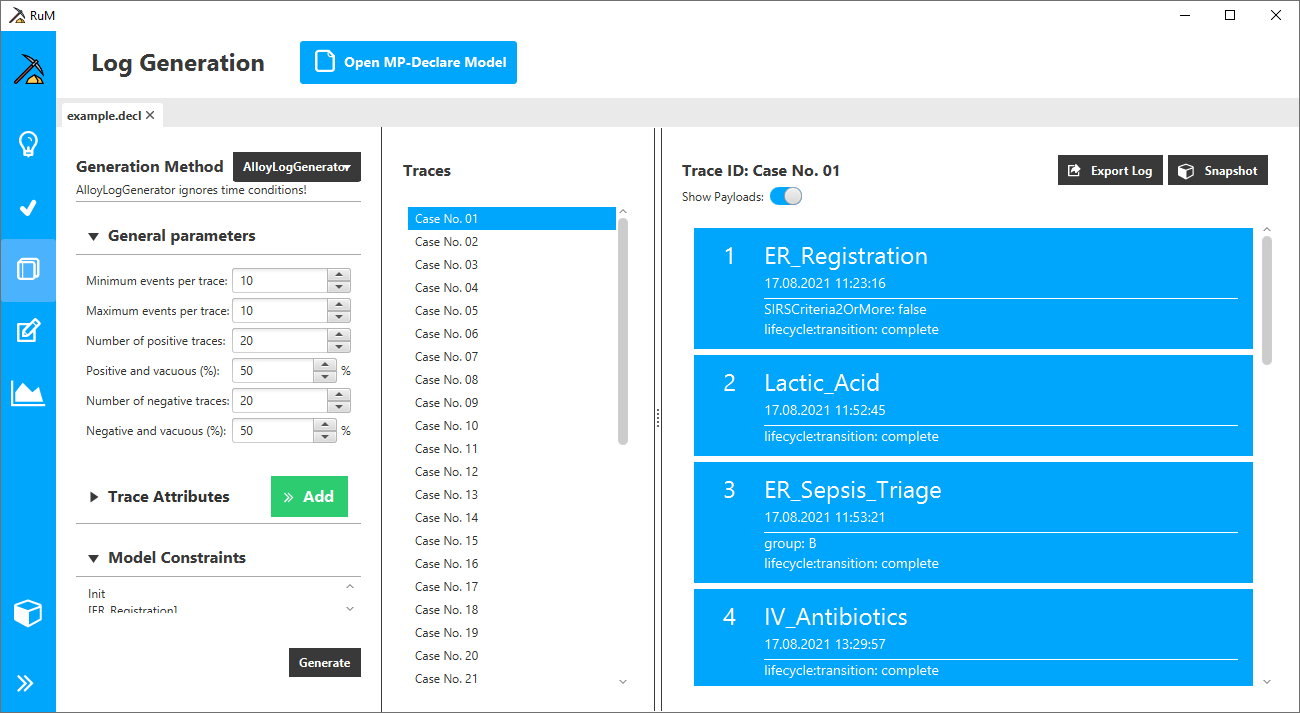
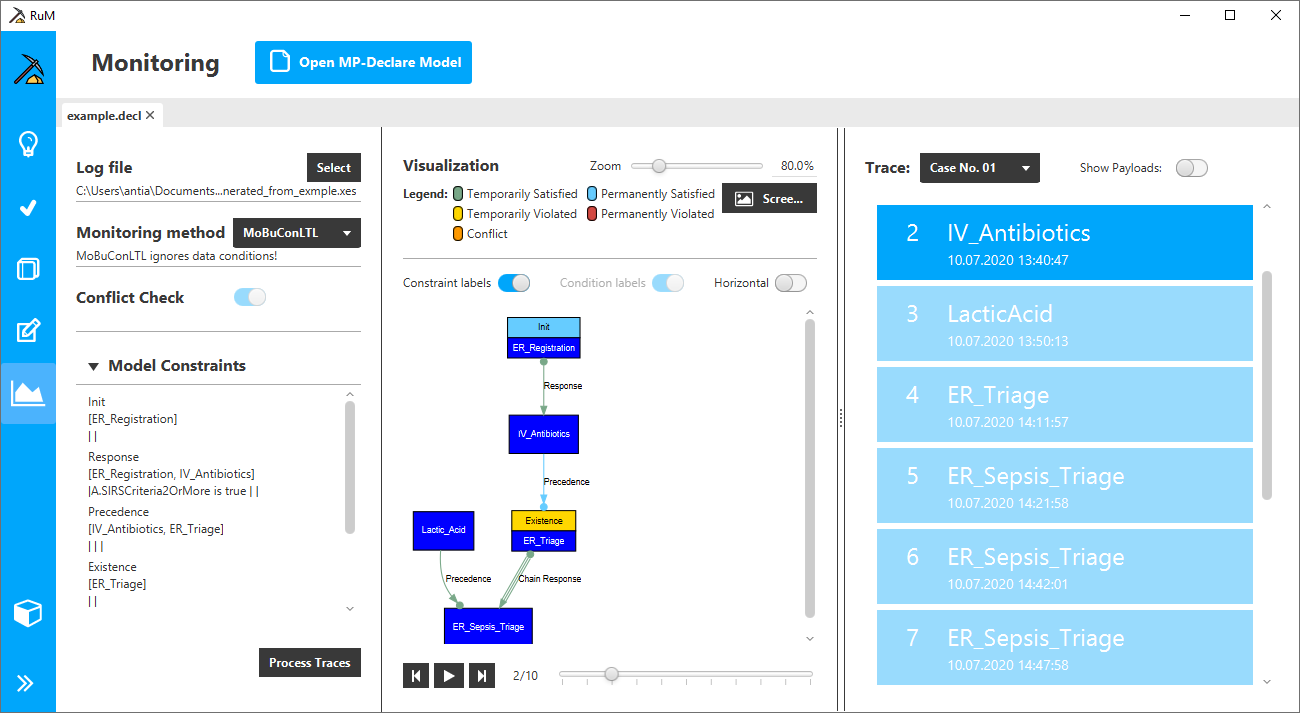
Monitoring
Monitoring supports the MP-Declare w Alloy, MobuconLTL and MobuconLDL methods. The monitors animate a Declare model by replaying a log over it and showing the constraints in the model that are temporarily or permanently satisfied or violated, after the occurrence of each event in the log.
Log Filtering
Log Filtering supports 17 types of basic filters, each fitting under attribute, performance, endpoints, follower, or timeframe. A mix of trace-based (filtering entire traces) and event-based (filtering specific events) filters is supported.
Furthermore, RuM integrates LTL Checker, which enables more advanced filtering based on 64 predefined LTL patterns ranging from templates of the Declare language to more complex workflow patterns in business processes.
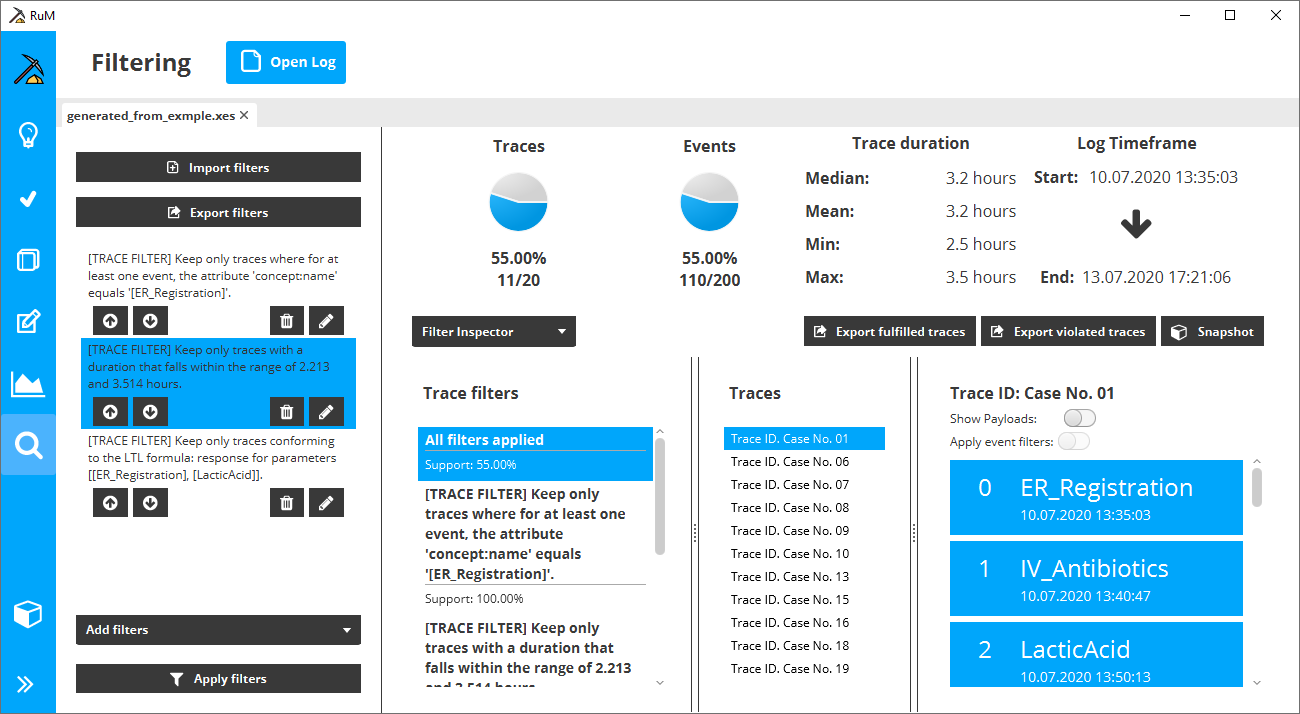
System requirements
- Operating system: Windows, Linux, macOS
- Minimum resolution: 1280×720
- Java 11 JDK
- Declo requires extra configurations as described here
- Some functionality may require write access to the folder that RuM is running from
RuM comes as a JAR package: no installation is needed! To run it, you only have to equip your machine with Java 11 JDK.
You can run RuM via command line (java -jar .\rum-0.7.2.jar) or, if JAVA_HOME is set, simply by double-clicking the JAR file.
If there are other versions of Java on the same computer then it may be necessary to use the command: java -Djava.library.path=. -jar .\rum-0.7.2.jar
Publications
Tedi Ibershimi, Diellsimeone Xhemalaj, Anti Alman, Ivan Donadello, Fabrizio Maria Maggi (ICPM Demos 2023)
Abstract – Conformance checking is an important task in process mining that checks whether a case of a business process is compliant or not with a process model. Process models in conformance checking can be expressed by using the procedural paradigm (e.g., through BPMN models or Petri nets) or the declarative one (e.g., through Declare models). Declarative process modeling languages represent the process behavior using temporal logic constraints mainly expressed with Linear Temporal Logic on finite traces (LTLf). In this paper, we present two solutions for checking LTLf temporal properties over the traces in an event log. The two solutions have been implemented in the RuM Java toolkit (equipped with a Graphical User Interface) and in the Declare4Py Python library. We also preliminary evaluate the time performance of both implementations showing that the execution times are reasonable for sufficiently complex checking tasks.
Anti Alman, Ivan Donadello, Fabrizio Maria Maggi, Marco Montali (PROFES Tutorials 2023)
Full Text BibTex Presentation (Declare and RuM) Presentation (Declare4Py)
Abstract – Process mining is one of the research disciplines belonging to the field of Business Process Management (BPM). The central idea of process mining is to use real process execution logs in order to discover, model, and improve business processes. There are multiple approaches to modeling processes with the most prevalent one being the procedural models like Petri nets and BPMN models. However, procedural models can be difficult to use for processes like software processes that are highly variable and can have a high number of different branches and exceptions. In these cases, it may be better to use declarative models, because declarative models do not aim to model the end-to-end process step by step, but they constrain the behavior of the process using rules thus allowing for more flexibility in the process executions. The goal of this paper is to introduce the main principles of declarative process mining (i.e., process mining based on declarative models) and to show which state-of-the-art declarative process mining techniques have been implemented in the RuM toolkit and in the Declare4Py Python library.
Anti Alman, Claudio Di Ciccio, Fabrizio Maria Maggi, Marco Montali, Han van der Aa (BPM Tutorials 2021)
Abstract – Flexibility is a key characteristic of numerous business process management domains. In these domains, the paths to fulfil process goals may not be fully predetermined, but can strongly depend on dynamic decisions made based on the current circumstances of a case. A common example is the adaptation of a standard treatment process to the needs of a specific patient. However, high flexibility does not mean chaos: certain key process rules still delimit the execution space, such as rules that prohibit the joint administration of certain drugs in a treatment, due to dangerous interactions. A renowned means to handle flexibility by design is the declarative approach, which aims to define processes through their core behavioural rules, thus leaving room for dynamic adaptation. This declarative approach to both process modelling and mining involves a paradigm shift in process thinking and, therefore, the support of novel concepts and tools. Complementing our tutorial with the same title, this paper provides a high-level introduction to declarative process mining, including its operationalisation through the RuM toolkit, key conceptual considerations, and an outlook for the future.
Anti Alman, Claudio Di Ciccio, Fabrizio Maria Maggi (ITBPM 2021)
Abstract – Declarative process modeling languages are especially suitable to model loosely-structured, unpredictable business processes. One of the most prominent of these languages is Declare. The Declare language can be used for all process mining branches and a plethora of techniques have been implemented to support process mining with Declare. The process mining application RuM integrates multiple Declare-based process mining methods into a single unified application and is developed to be the starting point for the use of Declare both in the industry and in the academia. RuM has been evaluated by conducting a qualitative user evaluation, the results of which have been used as input for further development. In this paper, we give a short overview of the current functionality of RuM, including the main improvements made thus far.
Anti Alman, Claudio Di Ciccio, Dominik Haas, Fabrizio Maria Maggi, Alexander Nolte (ICPM 2020)
Abstract – Declarative process modeling languages are especially suitable to model loosely-structured, unpredictable business processes. One of the most prominent of these languages is Declare. The Declare language can be used for all process mining branches and a plethora of techniques have been implemented to support process mining with Declare. However, using these techniques can become cumbersome in practical situations where different techniques need to be combined for analysis. In addition, the use of Declare constraints in practice is often hampered by the difficulty of modeling them: the formal expression of Declare is difficult to understand for users without a background in temporal logics, whereas its graphical notation has been shown to be unintuitive. In this paper, we present RuM, a novel application for rule mining that addresses the abovementioned issues by integrating multiple Declare-based process mining methods into a single unified application. The process mining techniques provided in RuM strongly rely on the use of Declare models expressed in natural language, which has the potential of mitigating the barriers of the language bias. The application has been evaluated by conducting a qualitative user evaluation with eight process analysts.
Anti Alman, Claudio Di Ciccio, Dominik Haas, Fabrizio Maria Maggi, Jan Mendling (ICPM Demos 2020)
Abstract – Procedural process modeling languages can be difficult to use for process mining in cases where the process recorded in the event log is unpredictable and has a high number of different branches and exceptions. In these cases, declarative process modeling languages such as DECLARE are more suitable. Declarative languages do not aim at modeling the end-to-end process step by step, but constrain the behavior of the process using rules thus allowing for more variability in the process model yet keeping it compact. Although there are several commercial and academic process mining tools available based on procedural models, there are currently no comparable tools for working with declarative models. In this paper, we present RuM, an accessible and easy-to-use rule mining toolkit integrating multiple DECLARE-based process mining methods into a single unified application. RuM implements process mining techniques based on Multi-Perspective DECLARE, namely the extension of DECLARE supporting data constraints together with controlflow constraints. In particular, RuM includes support for process discovery, conformance checking, log generation and monitoring as well as a model editor. The application has been evaluated by conducting a qualitative user evaluation with eight process analysts.
Han van der Aa, Karl Johannes Balder, Fabrizio Maria Maggi, Alexander Nolte (BPM Forum 2020)
Abstract – Declarative, constraint-based approaches have been proposed to model loosely-structured business processes, mediating between support and flexibility. A notable example is the Declare framework, equipped with a graphical declarative language whose semantics can be characterized with several logic-based formalisms. Up to now, the main problem hampering the use of Declare constraints in practice has been the difficulty of modeling them: Declare’s formal notation is difficult to understand for users without a background in temporal logic, whereas its graphical notation has been shown to be unintuitive. Therefore, in this work, we present and evaluate an analysis toolkit that aims at bypassing this issue by providing users with the possibility to model Declare constraints using their own way of expressing them. The toolkit contains a Declare modeler equipped with a speech recognition mechanism. It takes as input a vocal statement from the user and converts it into the closest (set of) Declare constraint(s). The constraints that can be modeled with the tool cover the entire Multi-Perspective extension of Declare(MP-Declare), which complements control-flow constraints with data and temporal perspectives. Although we focus on Declare, the work presented in this paper represents the first attempt to test the feasibility of speech recognition in business process modeling as a whole.
Anti Alman, Karl Johannes Balder, Fabrizio Maria Maggi, Han van der Aa (BPM Demos 2020)
Abstract – Proposed approaches for modeling knowledge-intensive processes include declarative, constraint-based solutions, which meet halfway between support and flexibility. A noteworthy example is the Declare framework, which is equipped with a graphical declarative language whose semantics can be expressed with multiple logic-based formalisms. So far, the practical use of Declare constraints has been mostly hampered by the difficulty of modeling them: the formal notation of Declare represents a steep learning curve for users lacking an understanding of temporal logic, while the graphical notation has proven to be unintuitive. This work presents Declo, a chatbot that allows users to easily define declarative constraints using natural language statements provided in the form of vocal or textual input. The supported constraints cover the entire Multi-Perspective extension of Declare (MP-Declare), complementing control-flow constraints with data and temporal perspectives.